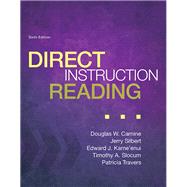Note: This is the loose-leaf version of Direct Instruction Reading and does not include access to the Enhanced Pearson eText. To order the Enhanced Pearson eText packaged with the loose-leaf version, use ISBN 0133827089.
Novice and expert teachers alike get the detailed guidance they need to be successful teaching any child who struggles with reading in the alphabetic writing system. Unique in its approach of leaving little to chance or guesswork, Direct Instruction Reading details how to teach, what to teach, why it is important to teach it, when to teach it, how long, how often, at what starting point in time, and to what criterion level of performance. For example, teaching format specify a) example words to teach; b) explicit directions for modeling how to read the words; c) explicit directions for how to guide students in their responses to teaching to teacher prompts; and d) explicit wording for correcting student errors. The book is designed to give both novice teachers with limited or no teaching experience, as well as the expert teacher with extensive teaching experience the detailed guidance they need to be successful teaching any child who struggles with reading in the alphabetic writing system. This new edition features chapter Learning Outcomes; a new chapter on Response to Intervention (RtI); information relating the Common Core State Standards (CCSS) to the Direct Instruction approach; web resources, video links, and other general research reference sources; explicit references and links to the most rigorous research available through the Institute of Education Sciences (IES); and updated research throughout. The Enhanced Pearson eText features embedded video.
Improve mastery and retention with the Enhanced Pearson eText*
The Enhanced Pearson eText provides a rich, interactive learning environment designed to improve student mastery of content. The Enhanced Pearson eText is:
- Engaging. The new interactive, multimedia learning features were developed by the authors and other subject-matter experts to deepen and enrich the learning experience.
- Convenient. Enjoy instant online access from your computer or download the Pearson eText App to read on or offline on your iPad® and Android® tablet.*
- Affordable. Experience the advantages of the Enhanced Pearson eText along with all the benefits of print for 40% to 50% less than a print bound book.
* The Enhanced eText features are only available in the Pearson eText format. They are not available in third-party eTexts or downloads.
*The Pearson eText App is available on Google Play and in the App Store. It requires Android OS 3.1-4, a 7” or 10” tablet, or iPad iOS 5.0 or later.










